TOYOTA PRIUS V 2015 ZVW40 / 1.G Owners Manual
Manufacturer: TOYOTA, Model Year: 2015, Model line: PRIUS V, Model: TOYOTA PRIUS V 2015 ZVW40 / 1.GPages: 621, PDF Size: 9.99 MB
Page 531 of 621

5308-2. Steps to take in an emergency
PRIUS v_OM_OM47887U_(U)
WARNING
■When using the compact spare tire
●Remember that the spare tire provided is specifically designed for use
with your vehicle. Do not use your spare tire on another vehicle.
●Do not use more than one compact spare tire simultaneously.
●Replace the spare tire with a standard tire as soon as possible.
●Avoid sudden acceleration, abrupt steering, sudden braking and shift-
ing operations that cause sudden engine braking.
■When the compact spare tire is attached
The vehicle speed may not be correctly detected, and the following sys-
tems may not operate correctly:
■Speed limit when using the compact spare tire
Do not drive at speeds in excess of 50 mph (80 km/h) when a compact
spare tire is installed on the vehicle.
The compact spare tire is not designed for driving at high speeds. Fail-
ure to observe this precaution may lead to an accident causing death or
serious injury.
■After using the tools and jack
Before driving, make sure all the tools and jack are securely in place in
their storage location to reduce the po ssibility of personal injury during a
collision or sudden braking.
■When stowing the flat tire
●Make sure the rear seatbacks ar e in their original position.
●Secure it using a tire tie-down belt. Otherwise, the flat tire may fly out
in case of sudden braking or an accident, resulting in death or serious
injury.
• ABS & Brake assist
• VSC
•TRAC
• Cruise control
*
• Dynamic radar cruise control*
• Pre-collision system*
• EPS
• Rear view monitor system
*
• LDA (Lane Departure Alert)*
• Navigation system*
*
: If equipped
Page 532 of 621
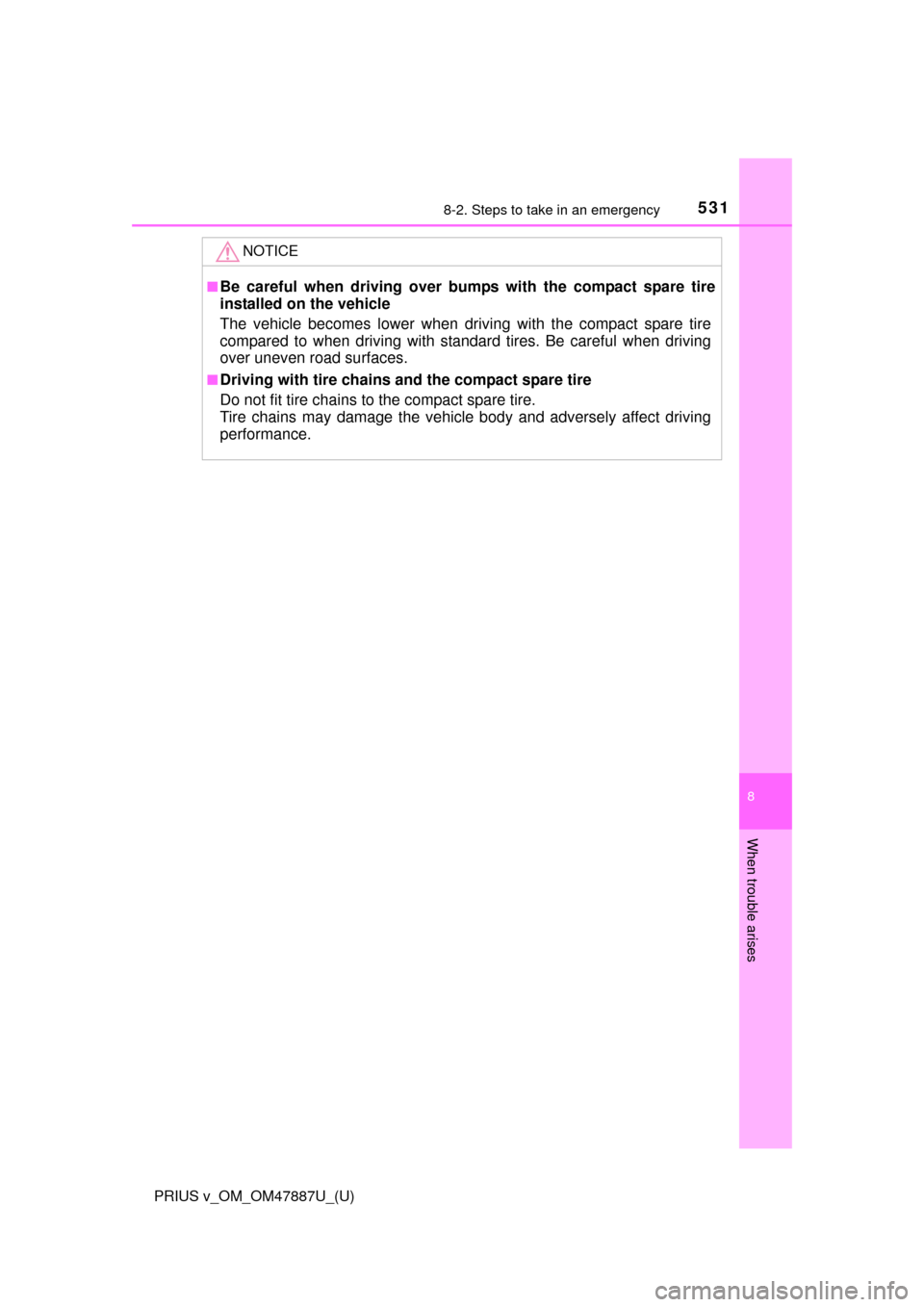
5318-2. Steps to take in an emergency
PRIUS v_OM_OM47887U_(U)
8
When trouble arises
NOTICE
■Be careful when driving over bumps with the compact spare tire
installed on the vehicle
The vehicle becomes lower when driving with the compact spare tire
compared to when driving with standard tires. Be careful when driving
over uneven road surfaces.
■Driving with tire chains and the compact spare tire
Do not fit tire chains to the compact spare tire.
Tire chains may damage the vehicle body and adversely affect driving
performance.
Page 533 of 621
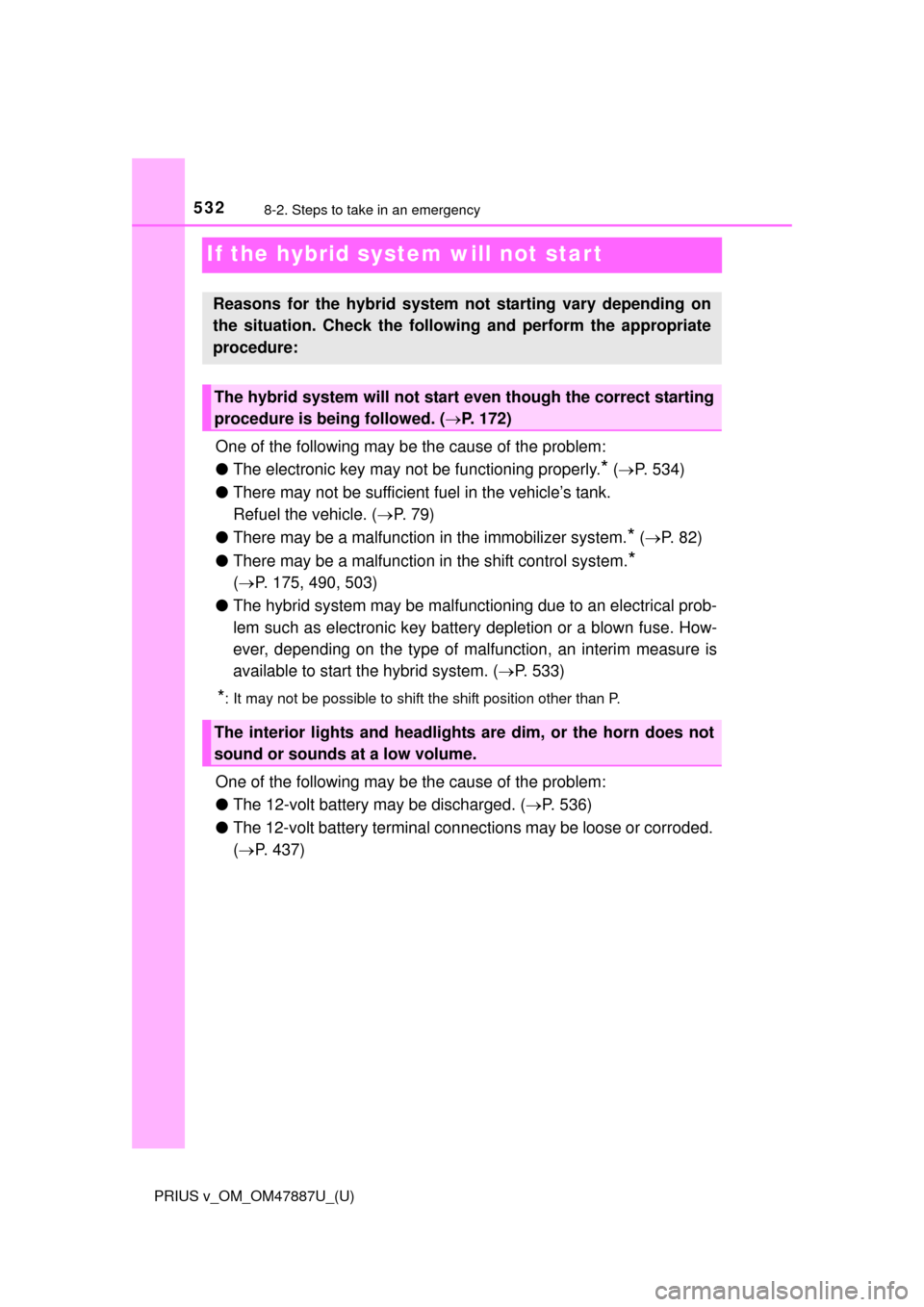
532
PRIUS v_OM_OM47887U_(U)
8-2. Steps to take in an emergency
If the hybrid system will not star t
One of the following may be the cause of the problem:
●The electronic key may not be functioning properly.
* ( P. 534)
● There may not be sufficient fuel in the vehicle’s tank.
Refuel the vehicle. ( P. 79)
● There may be a malfunction in the immobilizer system.
* ( P. 8 2 )
● There may be a malfunction in the shift control system.
*
( P. 175, 490, 503)
● The hybrid system may be malfunctioning due to an electrical prob-
lem such as electronic key battery depletion or a blown fuse. How-
ever, depending on the type of malfunction, an interim measure is
available to start the hybrid system. ( P. 533)
*: It may not be possible to shift the shift position other than P.
One of the following may be the cause of the problem:
● The 12-volt battery may be discharged. ( P. 536)
● The 12-volt battery terminal con nections may be loose or corroded.
( P. 437)
Reasons for the hybrid system not starting vary depending on
the situation. Check the follo wing and perform the appropriate
procedure:
The hybrid system will not start even though the correct starting
procedure is being followed. ( P. 172)
The interior lights and headlights are dim, or the horn does not
sound or sounds at a low volume.
Page 534 of 621
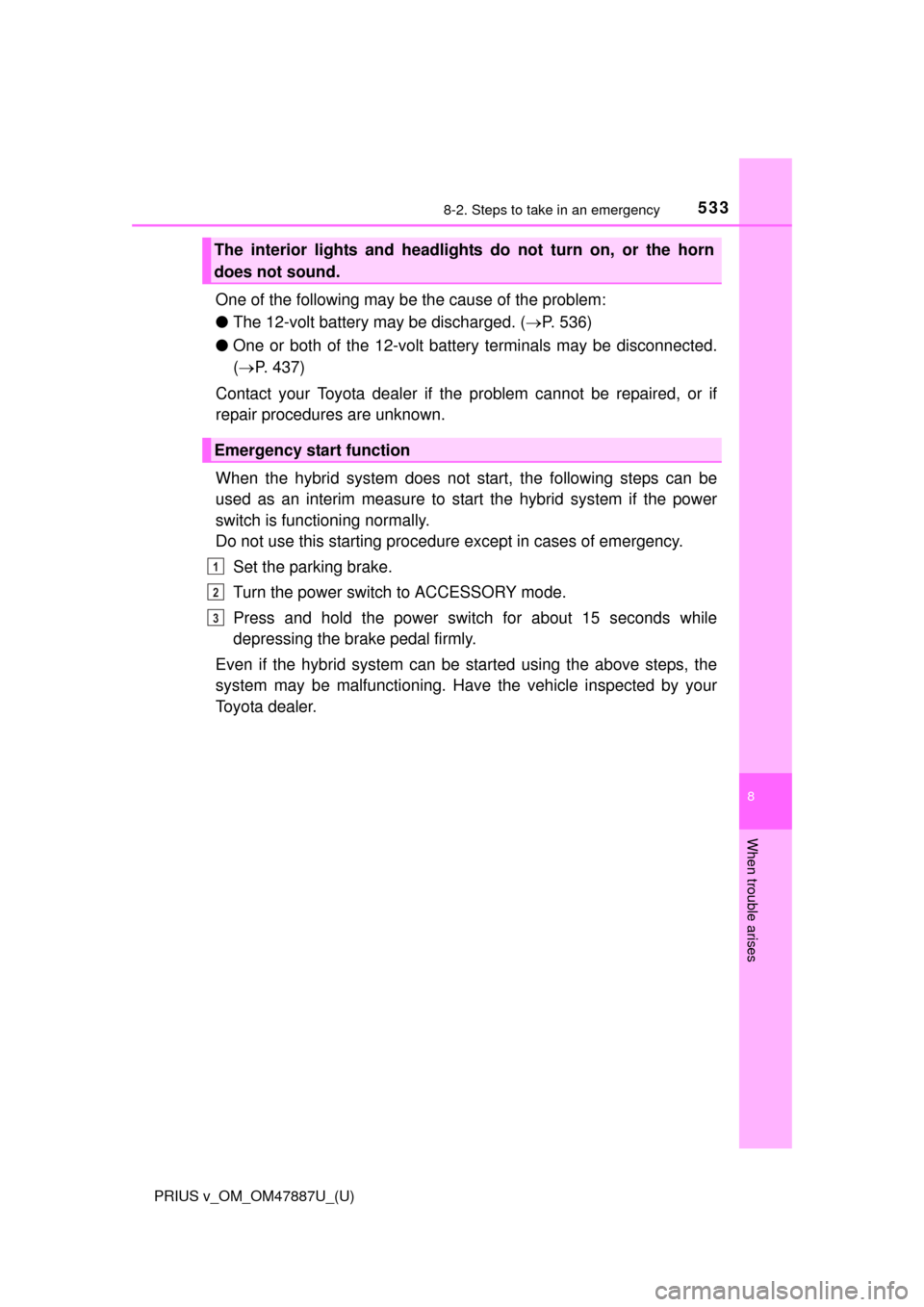
5338-2. Steps to take in an emergency
PRIUS v_OM_OM47887U_(U)
8
When trouble arises
One of the following may be the cause of the problem:
●The 12-volt battery may be discharged. ( P. 536)
● One or both of the 12-volt batter y terminals may be disconnected.
( P. 437)
Contact your Toyota dealer if the problem cannot be repaired, or if
repair procedures are unknown.
When the hybrid system does not start, the following steps can be
used as an interim measure to st art the hybrid system if the power
switch is functioning normally.
Do not use this starting procedure except in cases of emergency.
Set the parking brake.
Turn the power switch to ACCESSORY mode.
Press and hold the power switch for about 15 seconds while
depressing the brake pedal firmly.
Even if the hybrid system can be started using the above steps, the
system may be malfunctioning. Have the vehicle inspected by your
Toyota dealer.
The interior lights and headlight s do not turn on, or the horn
does not sound.
Emergency start function
1
2
3
Page 535 of 621
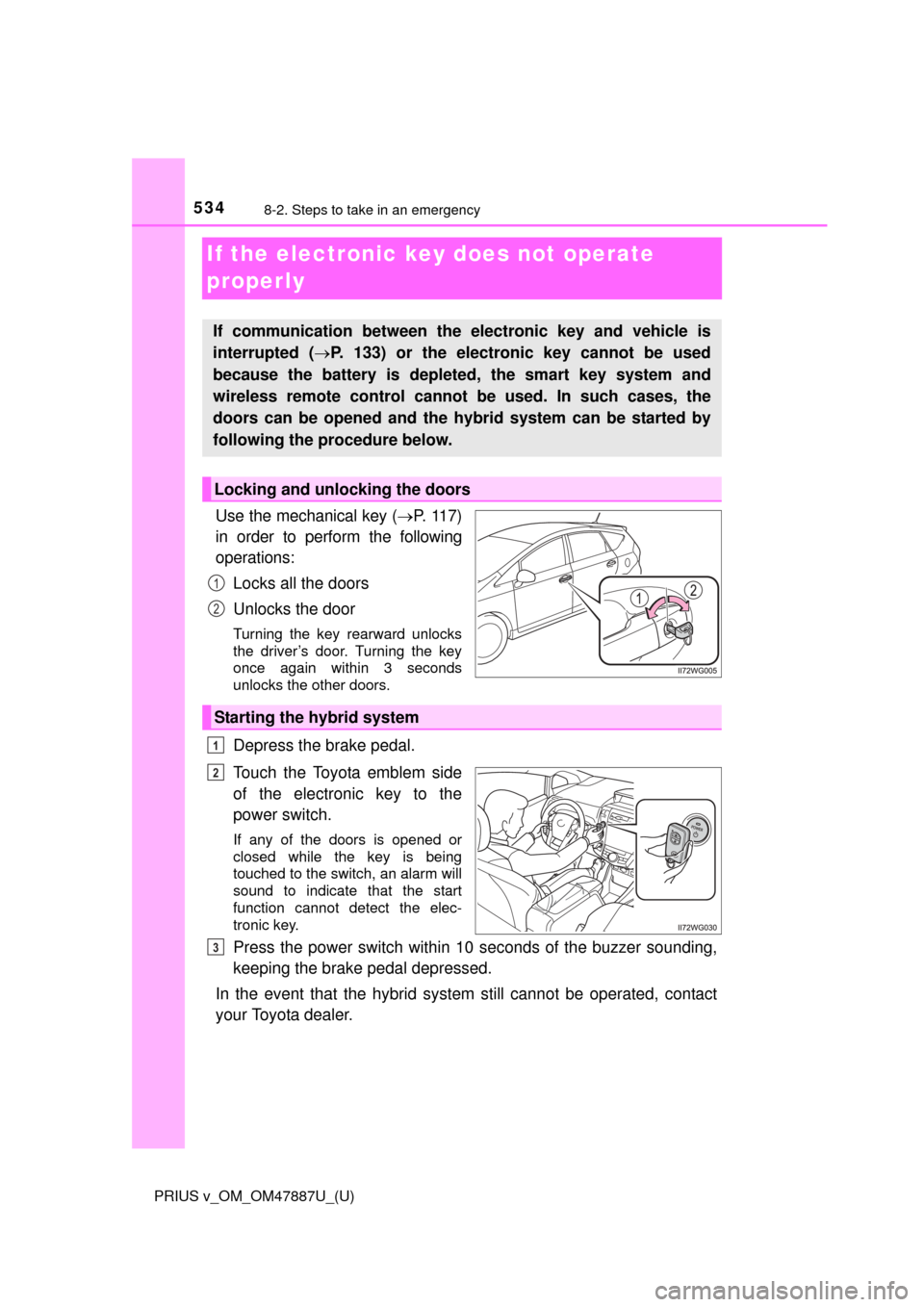
534
PRIUS v_OM_OM47887U_(U)
8-2. Steps to take in an emergency
If the electronic key does not operate
properly
Use the mechanical key (P. 11 7 )
in order to perform the following
operations:
Locks all the doors
Unlocks the door
Turning the key rearward unlocks
the driver’s door. Turning the key
once again within 3 seconds
unlocks the other doors.
Depress the brake pedal.
Touch the Toyota emblem side
of the electronic key to the
power switch.
If any of the doors is opened or
closed while the key is being
touched to the switch, an alarm will
sound to indicate that the start
function cannot detect the elec-
tronic key.
Press the power switch within 10 seconds of the buzzer sounding,
keeping the brake pedal depressed.
In the event that the hybrid system still cannot be operated, contact
your Toyota dealer.
If communication between the electronic key and vehicle is
interrupted ( P. 133) or the electronic key cannot be used
because the battery is depleted, the smart key system and
wireless remote control cannot be used. In such cases, the
doors can be opened and the hybr id system can be started by
following the procedure below.
Locking and unlocking the doors
1
2
Starting the hybrid system
1
2
3
Page 536 of 621

5358-2. Steps to take in an emergency
PRIUS v_OM_OM47887U_(U)
8
When trouble arises
■Stopping the hybrid system
Set the parking brake, shift the shift position to P and press the power switch
as you normally do when stopping the hybrid system.
■ Replacing the key battery
As the above procedure is a temporary measure, it is recommended that the
electronic key battery be replaced immediately when the battery is depleted.
(P. 459)
■ Changing power switch modes
Within 10 seconds of the buzzer sounding, release the brake pedal and press
the power switch.
The hybrid system does not start and modes will be changed each time the
switch is pressed. ( P. 174)
Page 537 of 621
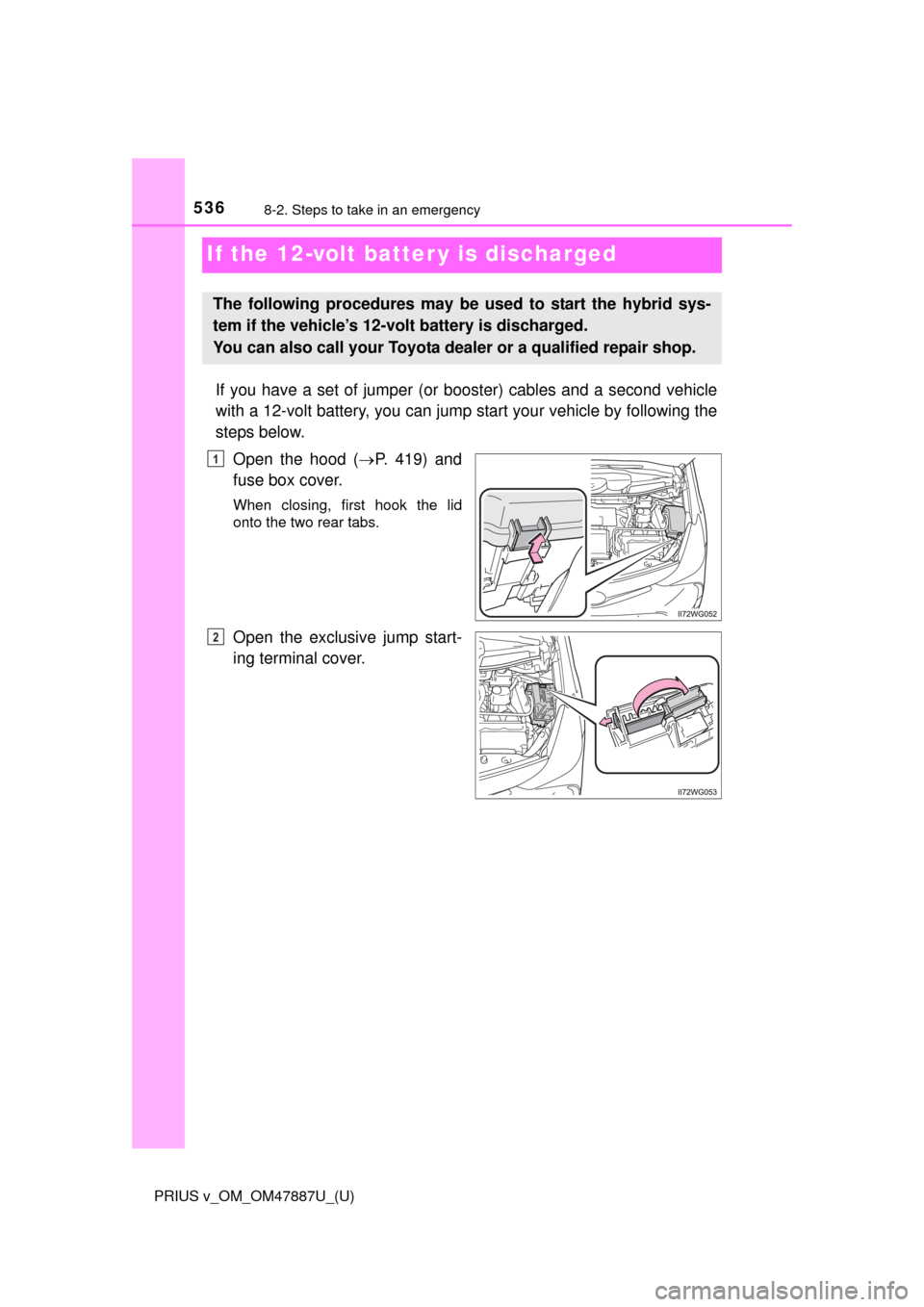
536
PRIUS v_OM_OM47887U_(U)
8-2. Steps to take in an emergency
If the 12-volt batter y is discharged
If you have a set of jumper (or booster) cables and a second vehicle
with a 12-volt battery, you can jump start your vehicle by following the
steps below.
Open the hood ( P. 419) and
fuse box cover.
When closing, first hook the lid
onto the two rear tabs.
Open the exclusive jump start-
ing terminal cover.
The following procedures may be used to start the hybrid sys-
tem if the vehicle’s 12-volt battery is discharged.
You can also call your Toyota de aler or a qualified repair shop.
1
2
Page 538 of 621
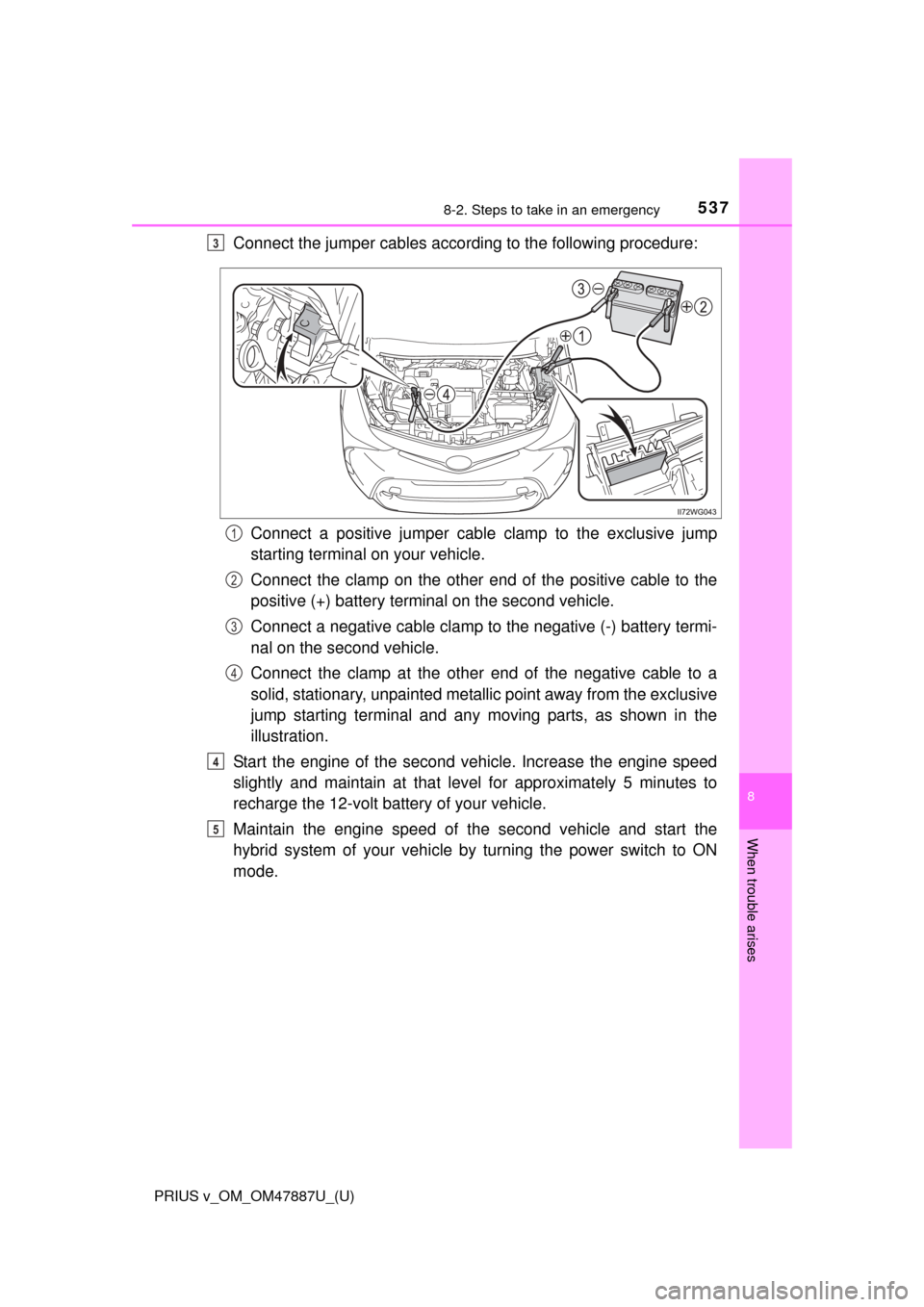
5378-2. Steps to take in an emergency
PRIUS v_OM_OM47887U_(U)
8
When trouble arises
Connect the jumper cables according to the following procedure:Connect a positive jumper cabl e clamp to the exclusive jump
starting terminal on your vehicle.
Connect the clamp on the other e nd of the positive cable to the
positive (+) battery terminal on the second vehicle.
Connect a negative cable clamp to the negative (-) battery termi-
nal on the second vehicle.
Connect the clamp at the other end of the negative cable to a
solid, stationary, unpainted metallic point away from the exclusive
jump starting terminal and any moving parts, as shown in the
illustration.
Start the engine of the second vehicle. Increase the engine speed
slightly and maintain at that le vel for approximately 5 minutes to
recharge the 12-volt battery of your vehicle.
Maintain the engine speed of t he second vehicle and start the
hybrid system of your vehicle by turning the power switch to ON
mode.3
1
2
3
4
4
5
Page 539 of 621

5388-2. Steps to take in an emergency
PRIUS v_OM_OM47887U_(U)
Make sure the “READY” indicator comes on. If the indicator light
does not come on, contact your Toyota dealer.
Once the hybrid system has started, remove the jumper cables in
the exact reverse order from which they were connected.
Close the exclusive jump starting terminal cover, and reinstall the
fuse box cover to its original position.
When installing, first hook the fuse box cover onto the two rear tabs.
Once the hybrid system starts, have the vehicle inspected at your
Toyota dealer as soon as possible.
■ Starting the hybrid system when th e 12-volt battery is discharged
The hybrid system cannot be started by push-starting.
■ To prevent 12-volt battery discharge
●Turn off the headlights and the audio system while the hybrid system is off.
● Turn off any unnecessary electrical components when the vehicle is running
at a low speed for an extended period, such as in heavy traffic.
■ When the 12-volt battery is removed or discharged
●The hybrid system may not start. ( P. 438)
● If the 12-volt battery discharges while the shift position is in P, it may not be
possible to shift the shift position to other positions. In this case, the vehicle
cannot be towed without lifting both front wheels because the front wheels
will be locked. ( P. 482)
● When the 12-volt battery is reconnected, start the hybrid system and con-
firm that the shift position can be changed to each position using the shift
position indicator.
■ Charging the 12-volt battery
The electricity stored in the 12-volt battery will discharge gradually even when
the vehicle is not in use, due to natural discharge and the draining effects of
certain electrical appliances. If the vehicle is left for a long time, the 12-volt
battery may discharge, and the hybrid system may be unable to start. (The
12-volt battery recharges automatically while the hybrid system is operating.)
6
7
8
Page 540 of 621
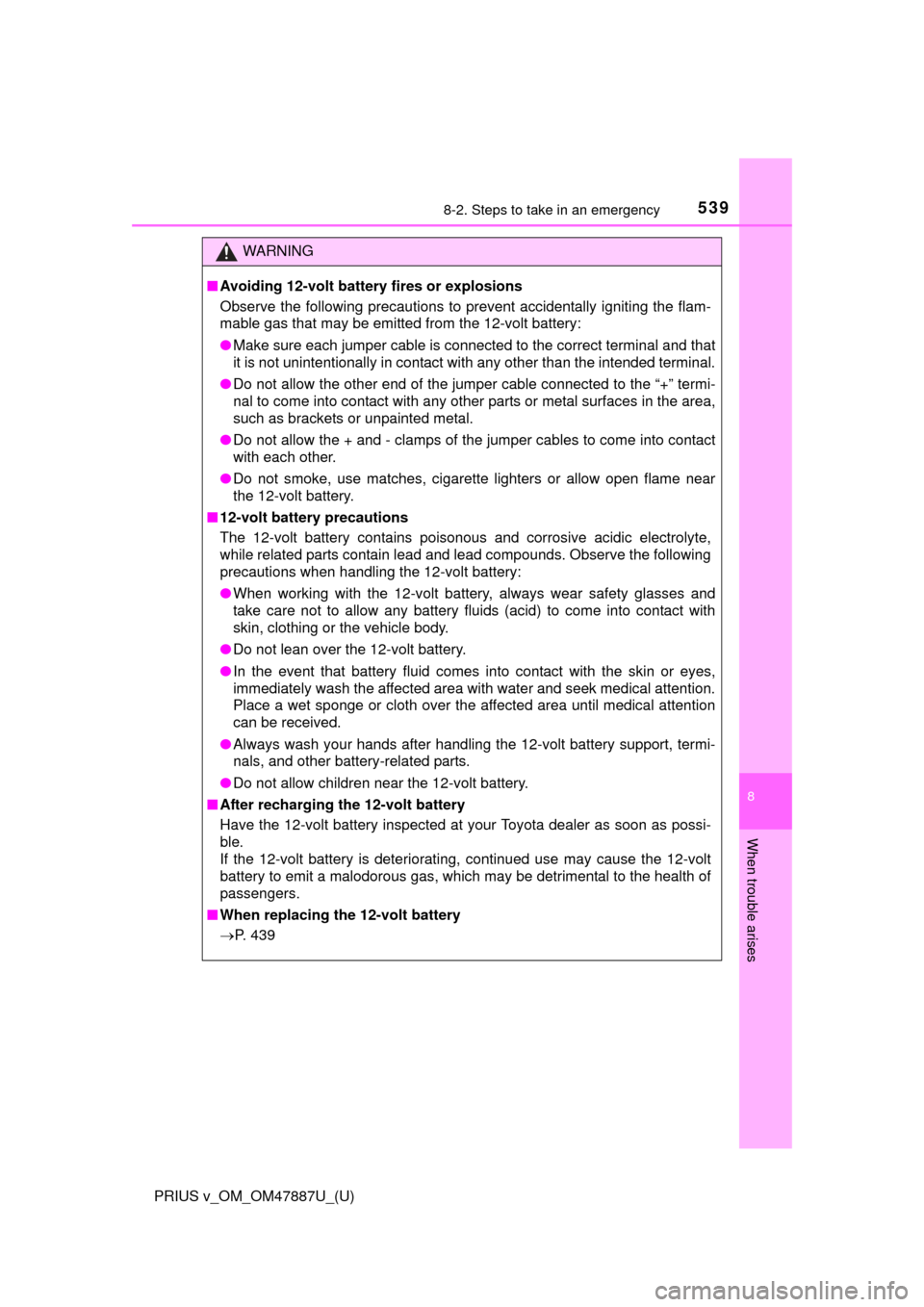
5398-2. Steps to take in an emergency
PRIUS v_OM_OM47887U_(U)
8
When trouble arises
WARNING
■Avoiding 12-volt battery fires or explosions
Observe the following precautions to prevent accidentally igniting the flam-
mable gas that may be emitted from the 12-volt battery:
● Make sure each jumper cable is connected to the correct terminal and that
it is not unintentionally in contact with any other than the intended terminal.
● Do not allow the other end of the jumper cable connected to the “+” termi-
nal to come into contact with any other parts or metal surfaces in the area,
such as brackets or unpainted metal.
● Do not allow the + and - clamps of the jumper cables to come into contact
with each other.
● Do not smoke, use matches, cigarette lighters or allow open flame near
the 12-volt battery.
■ 12-volt battery precautions
The 12-volt battery contains poisonous and corrosive acidic electrolyte,
while related parts contain lead and lead compounds. Observe the following
precautions when handling the 12-volt battery:
● When working with the 12-volt battery, always wear safety glasses and
take care not to allow any battery fluids (acid) to come into contact with
skin, clothing or the vehicle body.
● Do not lean over the 12-volt battery.
● In the event that battery fluid comes into contact with the skin or eyes,
immediately wash the affected area with water and seek medical attention.
Place a wet sponge or cloth over the affected area until medical attention
can be received.
● Always wash your hands after handling the 12-volt battery support, termi-
nals, and other battery-related parts.
● Do not allow children near the 12-volt battery.
■ After recharging the 12-volt battery
Have the 12-volt battery inspected at your Toyota dealer as soon as possi-
ble.
If the 12-volt battery is deteriorating, continued use may cause the 12-volt
battery to emit a malodorous gas, which may be detrimental to the health of
passengers.
■ When replacing the 12-volt battery
P. 439